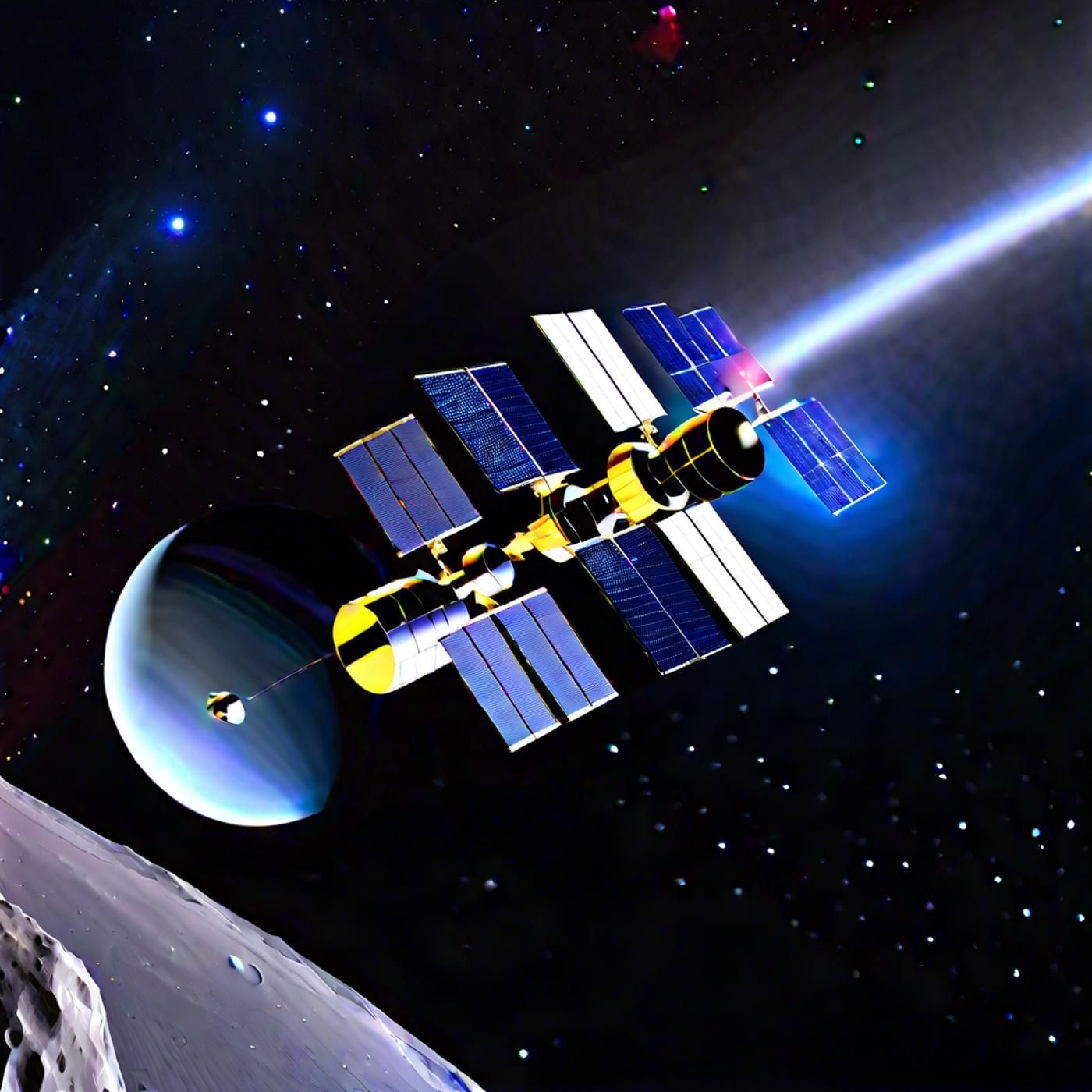S03E85: China's Lunar Milestone & NASA's Weather Satellite Triumph

Welcome to Astronomy Daily, the podcast that brings you the latest news and discoveries from the cosmos. I'm Anna and I'm thrilled to be your host for today. We have a lineup of captivating stories that span from groundbreaking space missions to...
Welcome to Astronomy Daily, the podcast that brings you the latest news and discoveries from the cosmos. I'm Anna and I'm thrilled to be your host for today. We have a lineup of captivating stories that span from groundbreaking space missions to intriguing research discoveries. In today's episode, we'll explore China's Chang'e 6 mission, which has made history by returning with the first-ever samples from the far side of the moon. We'll also dive into NASA's successful launch of the GOES-U weather satellite, set to revolutionize real-time weather tracking. Additionally, we'll discuss a compelling study from UC Riverside on how detecting certain greenhouse gases on exoplanets could hint at extraterrestrial intelligent life. But that's not all. We'll shed light on new insights into the sun's super granules, track recent advancements in detecting spy balloons and UFOs using satellites, and delve into the fascinating world of plate tectonics on other planets. So sit back, relax, and join me on this journey through the vast and wondrous universe.00:00 Astronomy Daily brings you the latest news and discoveries from the cosmos.
Thank you for tuning into Astronomy Daily. I'm Anna, and I hope you enjoyed today's journey through some of the most exciting news and discoveries in astronomy and space exploration. Remember to visit our website at [astronomydaily.io], where you can find regular updates on space news, access links to all the stories we featured today, and catch up on previous podcast episodes. We love bringing the wonders of the universe to your ears, and we appreciate your support and curiosity. Stay curious, keep exploring, and always look up. Until next time, take care and happy stargazing.
www.astronomydaily.io
www.bitesz.com
Become a supporter of this podcast:
https://www.spreaker.com/podcast/astronomy-daily-the-podcast--5648921
Become a supporter of this podcast: https://www.spreaker.com/podcast/astronomy-daily-the-podcast--5648921/support.
Astronomy Daily brings you the latest news and discoveries from the cosmos
Anna: Welcome to Astronomy Daily, the podcast that brings you the latest news and discoveries from the cosmos. I'm Anna and I'm thrilled to be your host for today. We have a lineup of captivating stories that span from groundbreaking space missions to intriguing research discoveries. In today's episode, we'll explore China's Changi 6th mission, which has made history by returning with the first ever samples from the far side of the moon. Also dive into NASA's successful launch of the Go zoo weather satellite, set to revolutionize real time weather tracking. Additionally, we'll discuss a compelling study from UC Riverside on how detecting certain greenhouse gases on exoplanets could hint at extraterrestrial intelligent life. But that's not all. We'll shed light on new insights into the sun's super granules, track recent advancements in detecting spy balloons and UFO's using satellites, and delve into the fascinating world of, uh, plate tectonics on other planets. So sit back, relax and join me on this journey through the vast and wondrous universe.
China's Chang'e six mission successfully returned to Earth with lunar samples
Let's get started. China's Chang'e six mission has marked a monumental achievement in space exploration by successfully returning to Earth with the first ever samples retrieved from the far side of the moon. The chang'e six return capsule touched down in the Siziwang banner area of Inner Mongolia in China, completing a nearly two month mission and a journey propelled by groundbreaking advancements in lunar technology. Launched on May 3, the Chang'e six probe was composed of four main an orbiter, lander, ascender, and returner. After reaching the far side of the moon, it landed in the Pol Aitkin basin, a, uh, region of great geological interest. Over the span of a few days, the probe meticulously collected samples from the lunar surface before departing on June 4. These samples are expected to offer profound insights into the moon's evolutionary history and geological processes. The return journey was an engineering marvel in itself. At approximately 3106 miles above the South Atlantic Ocean, the return capsule separated from the orbiter and entered Earth's atmosphere. It employed a sophisticated aerodynamic deceleration maneuver, re entered the atmosphere, and ultimately deployed parachutes at about 6 miles from landing, ensuring a safe descent to Earth. This mission also coincided with congratulations from President Xi Jinping and widespread acclaim from the scientific community. Yang Wei, a researcher at the Institute of Geology and Geophysics of the Chinese Academy of Sciences, emphasized that the Chang'I six mission sets a new precedent in lunar exploration and will undoubtedly lead to significant scientific discoveries beyond its immediate scientific impact. The change six mission symbolizes China's growing prowess in space exploration following the success of the Change Four mission, which first landed on the far side of the moon in 2019. These continued efforts not only enhance our understanding of the lunar surface, but also underscore the potential for future international collaborations in space exploration.
NASA launches its final goes U weather satellite using SpaceX's Falcon Heavy rocket
NASA has successfully launched its final goes U weather satellite using SpaceX's powerful Falcon heavy rocket. This event took place at Cape Canaveral in Florida, marking a pivotal moment in the advancement of real time weather tracking and forecasting. The Falcon Heavy, with its impressive 27 Merlin engines and 5.1 million pounds of thrust, blasted off at Ah precisely 526 EDT, propelling the satellite into its designated orbit. Within minutes. The go as U satellite was traveling faster than the speed of sound, with all systems performing perfectly. The excitement peaked as the two side boosters of the rocket separated and flawlessly navigated back to Cape Canaveral, executing picture perfect landings. The goes U weather satellite is the last in its series designed to provide high resolution imagery and data crucial for tracking severe weather events such as hurricanes. A NASA official highlighted how such satellites played a vital role during the devastating 2021 Hurricane Ida, offering real time data that was instrumental for timely and accurate weather forecasts. Following the launch, the satellite was placed into a geostationary transfer orbit before moving to its final position. This latest addition to the GEOIs family is expected to greatly enhance our ability to monitor and predict weather patterns, adapting quickly to the challenges posed by our changing climate. The successful launch not only showcases the capabilities of SpaceX's falcon heavy, but also underscores NASA's ongoing commitment to improving our understanding and prediction of Earth's dynamic weather systems.
Researchers at UC Riverside propose detection of artificial greenhouse gases on exoplanets
Researchers at UC Riverside have presented an intriguing proposition, the detection of certain artificial greenhouse gases on exoplanets as potential indicators of terraforming activity by intelligent life forms. This groundbreaking study focuses on gases that are unlikely to occur naturally in significant quantities. Instead, these gases are manufactured, meaning their presence in an, uh, exoplanet's atmosphere could signify advanced technological activity. The types of gases highlighted in their research include fluorinated versions of methane, ethane, and propane, along with compounds formed by mixing nitrogen and fluorine, or sulfur and fluorine. These specialized gases are incredibly effective at warming planetary climates. Some of them have a greenhouse effect thousands of times stronger than carbon dioxide. For example, sulfur hexafluoride has 23,500 times the warming potential of CO2, making it possible to warm a frigid planet to a level where liquid water could exist on its surface. Importantly, these gases are not only effective but also long lasting with some remaining stable in Earth like atmospheres for up to 50,000 years. This means they wouldn't need frequent replenishment, a, uh, considerable advantage for maintaining a stable, hospitable climate on a terraformed planet. Detection of these gases would be feasible even at low concentrations. Using current and soon to be launch space telescopes like the James Webb Space Telescope and upcoming european led missions, these telescopes can identify the unique infrared signatures of these gases, providing a new way to search for signs of extraterrestrial technology and perhaps intelligent life itself. This approach could potentially allow scientists to identify planets that have been deliberately engineered to support life, offering a tantalizing glimpse into the capabilities of advanced civilizations.
New study challenges existing theories of solar convection using sound waves
With each technological advancement, we come closer to answering one of humanity's greatest are we alone in the universe? Solar physicists have recently made significant progress in understanding the hidden depths of the sun's super granules using sound waves. The study, conducted by a team at NYU Abu Dhabi's center for Astrophysics and Space Science, challenges our existing theories of solar convection. By analyzing data from NASA's Solar Dynamics Observatory, these researchers identified structural peculiarities in approximately 23,000 super granules. Specifically, they discovered that the downflows within these super granules are about 40% weaker than the upflows. This disparity suggests that some components of the down flows are not visible through current observational methods. The team theorizes that small scale plumes, which are too fine to be detected by sound waves, might be transporting cooler plasma into the sun's interior. This would mean the standard mixing length theory, which is widely used to describe solar convection, does not fully account for these findings. This revelation has significant implications for our understanding of solar physics. The super granules play a critical role in transporting heat from the sun's interior to its surface. Thus, any new insights into their behavior could deepen our knowledge of solar dynamics and energy distribution. Researchers believe that these findings should inspire further investigation into the intricate mechanisms operating beneath the sun's surface, potentially unearthing more hidden secrets of, uh, our star. Researchers have developed a groundbreaking method to detect and track unidentified anomalous phenomena, or uaps, using commercial satellite imagery. This innovative approach was demonstrated by analyzing one of the most talked about incidents of recent the flight of a chinese spy balloon over the United States, which culminated in its shoot down by an air Force fighter jet. Researchers also scrutinized another similar incident, where a spy balloon traveled over Columbia. The method employs multispectral imagery from satellites such as Planet superdove series. The sensors on these satellites capture successive exposures across different spectral bands. By examining slight differences in these images, researchers can track moving aerial objects, even from space. This sophisticated image analysis not only helped determine the path and speed of the spy balloons, but also allowed for calculations of their altitudes, pinpointing them at approximately 21,200 meters over Missouri and 21,500 meters over Columbia. This method has broader implications as it could be adapted for tracking even more mysterious aerial phenomena. It forms part of Harvard University's Galileo project, which aims to gather high quality data that could be useful in hunting for celestial objects of potentially extraterrestrial origin. Techniques like these may become standard tools in aerial surveillance, enhancing our capability to monitor and possibly even identify uaps with unprecedented precision and accuracy. Plate tectonics is a fascinating geological process that plays a crucial role in shaping our planet and potentially others across the universe. On Earth, plate tectonics involves the movement of massive chunks of the lithosphere, driven by the convection currents in the molten mantle beneath. This dynamic process is responsible for forming mountain ranges, triggering volcanic activity, and causing earthquakes. Interestingly, our neighboring rocky planets and moons also exhibit geological activity, though not all engage in plate tectonics. Venus, for instance, presents a geological puzzle. Its surface is covered in volcanic features. And while it has a tectonically active surface with numerous volcanoes and lengthy lava flows, it's not clear if Venus has active plate tectonics. Like Earth, some scientists believe its surface regime might shift between episodic lid activity and a more squishy, deformable state under intense heat. Mars, on the other hand, exhibits a stagnant lid regime. While it has experienced significant volcanic activity in the past, most of its geological dynamism has subsided. The red planet's lithosphere is mostly static, with minimal surface movement compared to Earth. Mercury and our moon also fall under the category of stagnant lid bodies with little to no active geological processes due to their cooled interiors. Understanding these differences is not just an academic exercise it has profound implications for our search for life beyond Earth. Plate tectonics could be a key factor in maintaining a habitable planet, regulating atmospheric gases, and fostering stable climates. Detecting plate tectonics on exoplanets could therefore provide clues to their potential to host complex life forms. Future missions and advanced telescopes might even allow us to detect the signs of such geological processes on distant worlds, bringing us one step closer to finding other habitable environments in our galaxy. The study of plate tectonics thus bridges our understanding of planetary formation, geological activity, and the potential for life in the universe. Thank you for tuning into astronomy daily. I'm Anna and I hope you enjoyed today's journey through some of the most exciting news and discoveries in astronomy and space exploration. Remember to visit our website at astronomydaily IO, where you can find regular updates on space news, access links to all the stories we featured today, and catch up on previous podcast episodes. We love bringing the wonders of the universe to your ears, and we appreciate your support and curiosity. Stay curious, keep exploring, and always look up. Until next time, take care and happy stargazing.
New to Astronomy Daily - The Podcast?
Here are some great episodes to start with.




















